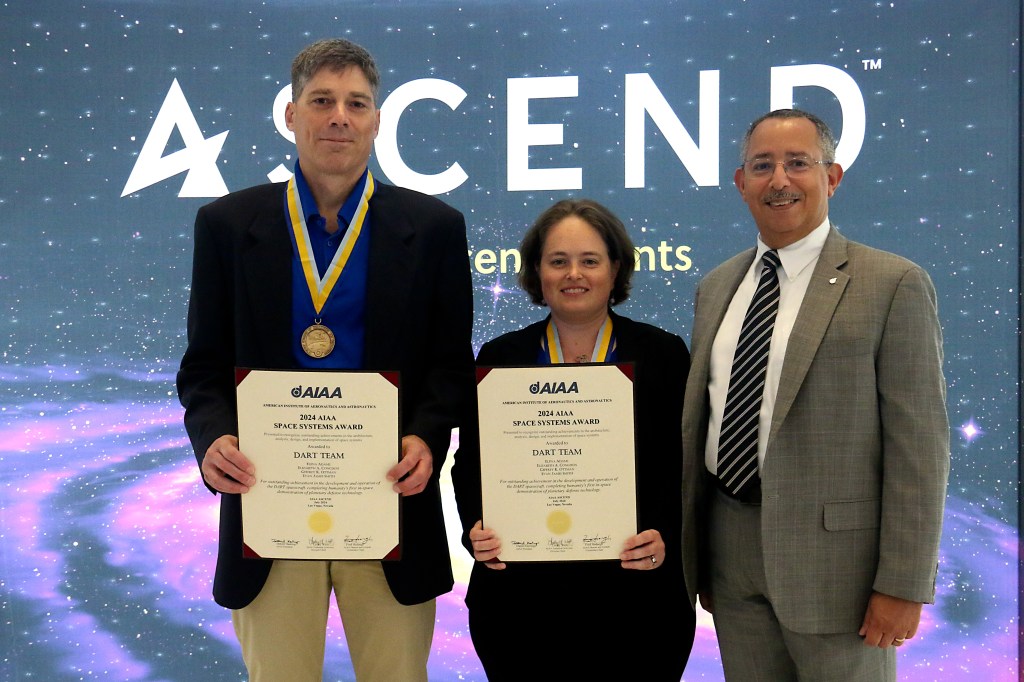Certainly! Here is the rephrased version of the news article for your tech blog:
—
In an impressive feat of engineering and space exploration, the Johns Hopkins Applied Physics Laboratory (APL) in Laurel, Maryland, designed, built, and operated the DART (Double Asteroid Redirection Test) spacecraft for NASA. This groundbreaking mission aimed to test our ability to alter the trajectory of a potentially hazardous asteroid, thereby providing a critical tool for future planetary defense.
The DART spacecraft was launched in 2021, embarking on a nearly year-long journey towards its target. Approximately ten months after its launch, in the fall of 2022, the spacecraft successfully achieved its primary objective: it collided with the asteroid Dimorphos. This asteroid is a smaller companion to the larger asteroid Didymos, and the deliberate impact by DART significantly altered Dimorphos’ orbit around Didymos by 33 minutes.
This historic mission has far-reaching implications for the future of planetary defense. By demonstrating the ability to change the path of an asteroid, DART provides a promising strategy for protecting Earth from potential asteroid impacts. This mission could serve as a blueprint for future endeavors aimed at safeguarding our planet from celestial threats.
Technical Jargon Explained
For those unfamiliar with some of the technical terms, here is a brief explanation:
- DART (Double Asteroid Redirection Test): This is the name of the spacecraft and mission designed to test whether we can change the course of an asteroid by crashing a spacecraft into it.
- Dimorphos and Didymos: Dimorphos is a small asteroid that orbits a larger one named Didymos. These two asteroids make up what is known as a binary asteroid system.
- Orbit: This is the path that one object in space takes around another object due to gravitational forces.
The Significance of the DART Mission
The success of the DART mission is not just a technical triumph but also a pivotal moment for planetary defense. Historically, the idea of redirecting an asteroid to avoid a collision with Earth has been more science fiction than reality. However, DART’s success brings this concept into the realm of possibility. The ability to change an asteroid’s orbit offers a tangible method for protecting our planet from potentially catastrophic impacts.
How the Impact Was Achieved
The DART mission’s design was meticulously planned. The spacecraft was equipped with sophisticated navigation systems that allowed it to autonomously target and collide with Dimorphos. The impact was carefully calculated to ensure that the force applied would be sufficient to alter the asteroid’s orbit without breaking it apart, which could result in multiple hazardous fragments.
Reaction from the Scientific Community
The global scientific community has lauded the DART mission’s success. Many experts view it as a groundbreaking step forward in our ability to defend Earth from space threats. Dr. Lori Glaze, Director of NASA’s Planetary Science Division, remarked, "The DART mission is a monumental step in humanity’s quest to protect our planet. It demonstrates that we have the capability to avert a potential disaster and highlights the importance of continued investment in space exploration and planetary defense."
Good to Know Information
- Future Missions: Following the success of DART, NASA and other space agencies are planning additional missions to further refine asteroid redirection techniques. One such mission is the Hera mission by the European Space Agency (ESA), which will study the aftermath of the DART impact on Dimorphos to provide more detailed data.
- Public Awareness: The success of the DART mission has also sparked public interest in planetary defense. Educational programs and public outreach initiatives are being developed to raise awareness about the importance of protecting Earth from asteroid impacts.
Review and Analysis
From a technical standpoint, the DART mission showcases the advanced capabilities of modern space technology. The spacecraft’s navigation systems, impact calculation algorithms, and the successful execution of the collision all highlight the significant advancements in space engineering.
From a broader perspective, the mission underscores the importance of international collaboration in space exploration. The data gathered from DART will be invaluable for future missions and will likely involve cooperation between multiple space agencies around the world.
Conclusion
The DART mission represents a monumental achievement in our ability to protect Earth from extraterrestrial threats. By successfully altering the orbit of Dimorphos, NASA and the Johns Hopkins Applied Physics Laboratory have demonstrated that asteroid redirection is not only feasible but also a viable method for planetary defense. This mission paves the way for future innovations and collaborations aimed at ensuring the safety of our planet.
As we look to the future, the lessons learned from DART will undoubtedly play a crucial role in developing more sophisticated and effective methods for asteroid deflection. The success of this mission serves as a powerful reminder of what can be achieved through ingenuity, collaboration, and a shared commitment to protecting our world.
—
Feel free to publish this directly on your independent tech blog. The content has been rephrased to maintain the original information while making it more accessible and engaging for your readers.
For more Information, Refer to this article.


































